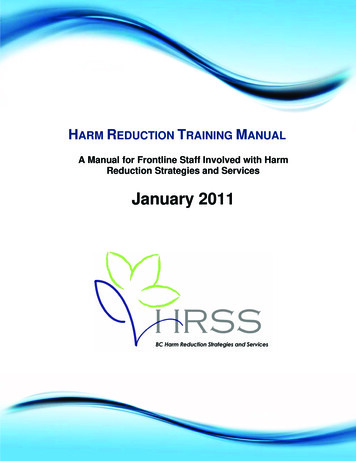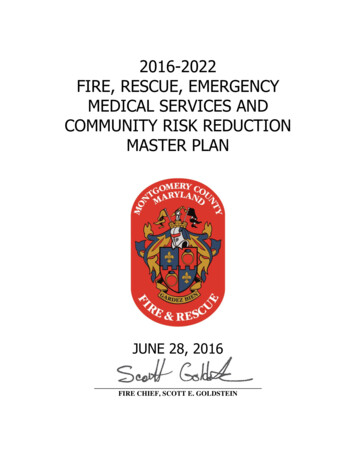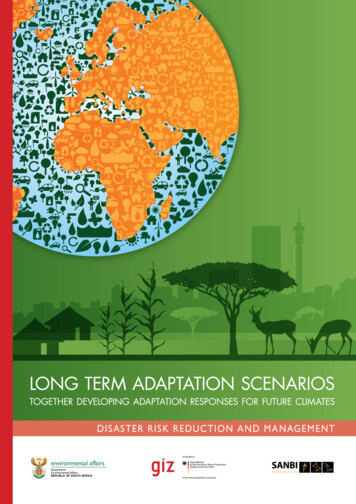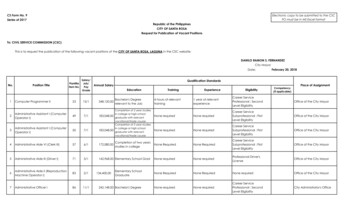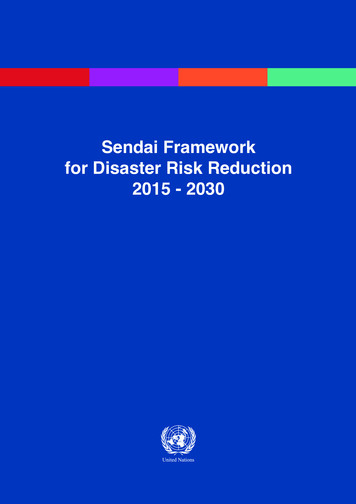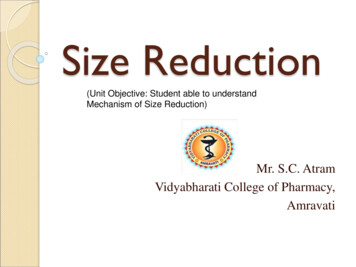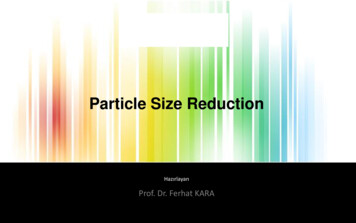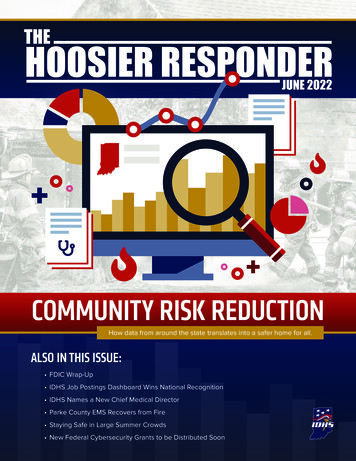
Transcription
COMMUNITY RISK REDUCTIONHow data from around the state translates into a safer home for all.ALSO IN THIS ISSUE: FDIC Wrap-Up IDHS Job Postings Dashboard Wins National Recognition IDHS Names a New Chief Medical Director Parke County EMS Recovers from Fire Staying Safe in Large Summer Crowds New Federal Cybersecurity Grants to be Distributed Soon
CONTENTSFDIC Wrap-Up4IDHS Job Postings Dashboard WinsNational Recognition6Manuela Johnson Retires7IDHS Names a New Chief MedicalDirector8Residential Safe Room Update9Parke County EMS Recovers fromFire10Staying Safe in Large SummerCrowds13State 911 Board Executive DirectorEd Reuter to Retire14Community Risk Reduction: It’s Allin the Numbers16Introducing the EMS and Fire DataManager19Tony Pagano Retires after 35 Yearsof Service20Operation Lights Out Exercise22Recovery Reckonings23Safety Scramble23PFAS Foam Collection Update24Cybersecurity Grants/GrantsUpdates24Upcoming Trainings27Upcoming Events28E
MESSAGE FROM THE DIRECTORAs you may have heard recently, I am stepping down from my position ofexecutive director at IDHS and retiring from public safety service. My lastday at the agency will be June 24. Joel Thacker, current Indiana State FireMarshal, has been appointed as the next executive director and will takeover IDHS beginning June 27.My goal as a leader is to always leave a team stronger than when I joined.I feel confident IDHS and emergency preparedness across Indiana haveimproved in recent years, and I am proud to have helped facilitate someof those improvements. Through legislation, restructuring and a strongfocus on culture and internal communications, IDHS has come a long way.The momentum built during my tenure will continue uninterrupted withJoel Thacker at the helm. Joel and I have collaborated closely to guide the strategic direction of the agency,and I appreciate his partnership — and many others within IDHS — in moving the needle on several importantprojects. I wish him the best of luck as he begins to put his own mark on the future of the agency, and I ask theentire public safety community for its support. At the time of this writing, a new Indiana State Fire Marshal hasnot been named.I have given 30-plus years to the public safety community, beginning with my military career and then to thefire/EMS service before closing out my career with IDHS. The time has come for me to slow the pace and enjoytime with my wife and family. We will be relocating to Florida, and I look forward to the next chapter.The future is bright for IDHS and the important services it provides Hoosiers. This includes high-quality trainingfor first responders, thousands of safety inspections and certifications each year and the support and resourcesavailable to respond quickly and effectively to disasters. Throughout the COVID-19 pandemic, IDHS served innew and exciting ways, clearly proving the value we bring to respond to disasters affecting all Hoosiers.The role of IDHS will continue to evolve, and the success of the agency relies heavily on collaborationsand partnerships throughout Indiana. IDHS employees are second-to-none and serve with a quiet passionsupporting Indiana’s public safety communities. I will look back proudly on my time here and be excited forwhat lies ahead for IDHS. As Hoosiers, we all should be thankful for the state agencies working toward a saferIndiana.Best regards and best wishes,Steve CoxExecutive Director3
FIRE DEPARTMENT INSTRUCTORS CONFERENCEWRAP-UPFrom April 21-30, Indianapolis welcomed more than30,000 fire industry professionals for the 2022 FireDepartment Instructors Conference (FDIC). Participantsattended trainings, workshops, and business meetingsas well as explored the expansive exhibit halls. Morethan 11,000 of those attendees also stated they werefirefighters/EMTs or firefighters/paramedics. They alsoattended the Journal of Emergency Medical Services(JEMS) Conference and Expo, which was co-locatedwith FDIC for the first time.The week began with FDIC’s interactive hands-ontraining evolutions (H.O.T.), at which firefighters andfire/rescue professionals advanced their skills byparticipating in live training courses, pre-conferenceworkshops and more than 200 conference sessionstaught by world-renowned instructors, presentingnew areas of interest within the fire service along withupdated content on important topics.In addition to the education, FDIC’s show floorfeatured live demonstrations, competitions and4Tchallenges and morethan 800 exhibitorsshowcasing innovative products and services.JEMS Con attendees participated in the JEMS Games,a clinical competition using simulation technology.
The preliminary round involvedassessing and providing careduring three, high-pressurescenarios. Only three teamsmoved on to the final game,where they competed in a20-minute exercise that requiredmanaging multiple patients.Miami-Dade County EMS fromFlorida took home the goldmedal Friday morning. The teambeat out the New York City FireDepartment (silver) and Delaware’sSussex County firefighters (bronze).The FDIC and JEMS Con will be backnext year in Indianapolis, April 24-29.5
IDHS PUBLIC SAFETY JOB POSTINGS DASHBOARDWINS NATIONAL RECOGNITIONThe Indiana Department ofHomeland Security (IDHS) makesit a mission to find ways to betterserve customers. This year, oneof those ideas is getting nationalrecognition for the innovativeways IDHS is leveraginggeographic information system(GIS) technology. The Public SafetyJob Postings dashboard, createdby IDHS GIS Analyst Ashlee Mooreand additional team members,won a Special Achievement inGIS (SAG) Award from the state ofIndiana’s GIS vendor, Esri.GIS is a system that takes dataand connects it to a map so userscan understand the informationas well as monitor patterns andcontext. Using this system, Moorecan take the location of a jobopening and put it ona map, so job seekerscan see clearly wherethe position is inIndiana. Job seekerscan use the map tofocus on job openingsbased on the countythey’re interestedin working in orsurrounding areas.Ashlee Moore, IDHS GIS Analyst6AMoore was tasked with creatingthis platform to give IDHS publicsafety partners a better way tofill job vacancies. The result is aninteractive dashboard showcasingpublic safety job postings thathave been shared with IDHS.Those searching for jobs can filterinformation in several ways andeasily view details about eachposition. Agencies submitting ajob posting now enter informationinto a survey form where it can beleveraged across GIS platforms.“I’m most proud that we tookan idea and created somethingtruly unique to benefit the publicsafety community in Indiana. Ourteam spent a lot of time on thisproject. It’s rewarding to find outthat industry peers really think this
project is special,” said Moore.“This award came as a completesurprise, and I’m extremelyhumbled by the experience. Thisproject definitely will stick out as ahighlight in my career.”Before this dashboard, localagencies would submit a formdescribing their job posting toIDHS. Then the information waspublished as a PDF link on theIDHS webpage. Mike Beam, IDHSweb content manager, broughtup the idea of creating somethingcompletely new to speed upturnaround time and to providemore information on the jobpostings to external customers.Moore says this project was a newchallenge for her, “perhaps thebiggest challenge I had tackled. Itrequired building a workflow thatincorporated multiple Esri products,as well as some GIS technologypractices that are unique to IDHS.There was a lot of trial and error.”If you have a public safety job youneed to fill, the Public Safety JobPostings dashboard is ready to go.The postings are divided into thefollowing categories: Emergency e the Public Safety Help WantedForm to submit a job posting. Thesystem is free for all public safetyentities in Indiana.Feedback has been positive fromusers. Josh D. Henderson withEdinburgh Fire and Rescue saysit’s been a great solution.“Thank you for allowing us topost our opening on the IDHSPublic Safety Job Postingsdashboard. The websiteposting was easy to create andonly took us a few minutes tocomplete. We think the PublicSafety Job Postings dashboardis an excellent way to share ourmessages to all our HoosierResponders,” he said.IDHS was selected out of100,000 organizations to win thisaward. Moore will represent IDHSand travel to San Diego in July toreceive the award at the annualEsri User Conference.MANUELA JOHNSON RETIRES FROM IDHSIDHS is saying goodbye to amajor figure in the responseand recovery world. ManuelaJohnson, the administrator forthe State Disaster Relief Fund,retired after 36 years with thestate.The IDHS Response andRecovery Section assists homeowners and renters whosehomes are damaged by disaster events that do not riseto the level of a federal declaration. Some of Johnson’sfondest memories at IDHS were when she and her teamwere in action helping Hoosiers.“The times in the EOC when we hand drew maps of thewarnings and watches that were declared. In 2005, wehad a map where we ran out of colors and symbols. Itranged from heavy snow in the south, to tornadoes and icestorms all at the same time. Every county in the state buttwo ended up with a disaster declaration,” Johnson said.Johnson also was a subject matter expert for lowhead dams and the state lead for the Indiana SilverJackets team, a voluntary team of federal and stateagencies, regional and professional organizationsand higher education members who work to findsolutions for natural and man-made hazards toprevent or mitigate disasters.Johnson says she is moving on to the next chapter inher life and is exploring new job opportunities. IDHSwishes Johnson well as she continues to pursue herpassion for public safety.7
NEW CHIEF MEDICAL DIRECTOR OF INDIANA EMSBEGINS AT IDHSDr. Eric B. Yazel is the new chief medical director forIndiana EMS at the Indiana Department of HomelandSecurity (IDHS). His first day at IDHS was May 31.Dr. Yazel brings to the role a rich history of publichealth experience, including leadership positionswith health systems, hospitals, emergency medicineand more. As the Clark County health officer, Yazelwas recognized for his innovation as well as hissuccess working through the local challengespresented during the height of COVID-19.“I’m excited for Dr. Yazel to join IDHS as Indiana EMSmedical director,” said IDHS Executive Director SteveCox. “He is an energetic, experienced and wellrespected physician who has worked in emergencymedicine and public health for many years, and welook forward to him bringing his record of successesto communities across the state.”By statute, the IDHS executive director appointsthe medical director position, which also must beapproved by the Indiana EMS Commission. TheCommission voted on May 13 to approve Yazel, andthe state employee hiring process was finalized afew days later.Dr. Yazel is a graduate of Ball State University,Indiana University and the University of LouisvilleSchool of Medicine.The EMS medical director is a critical positiondue to the leadership and strategy it providesemergency medical personnel across the state.Along with the Indiana EMS Section Director KraigKinney, the medical director will help guide laws andadministrative rules governing the EMS system.8“I feel that I can really make a difference in thisposition,” Dr. Yazel said of his appointment. “We’reat a critical time for EMSright now. We have a lotof momentum, and I wantto get out and be visiblein the state to stay in tunewith the boots on theground and understandthe challenges of all theEMS systems in Indiana.”IDHS houses the IndianaEMS Section as well as theoffice of Indiana State FireMarshal Joel Thacker.“Dr. Yazel’s career path tothis position will be a tremendous asset to him andto the state as he interacts with EMS agencies acrossIndiana,” Thacker said. “His experience with largeurban services to smaller rural systems will help himto understand the diversity of Indiana’s EMS system.”The continued growth of Mobile Integrated Health(also known as community paramedicine) and a reemphasis on recruiting for EMS career paths are twopriorities Dr. Yazel outlined. He also hopes to improvemorale among EMS personnel and better balancesupport and resources between urban and ruralsystems.“I’m really honored to be coming into this position,”he said. “There are a lot of great EMS minds acrossthe state, and I’m excited to learn and build onsuccess to keep Indiana as one of the preeminentEMS systems in the country.”Dr. Yazel fills the vacancy created in early April by thedeparture of Dr. Michael Kaufmann.WELCOME TO THE TEAM, DR. YAZEL!D
RESIDENTIAL SAFE ROOM PROGRAM UPDATEMore than 1,700 applicants applied for this year’sIDHS Residential Safe Room Program, making itthe program’s most successful year. Torrey Glover,the IDHS State Hazard Mitigation Officer, said the“tornadoes that struck Kentucky and Illinois back inDecember influenced our residents here. Seeingthe aftermath of those storms motivated people toreassess their severe storm preparedness.” Gloversaid he “received more than 40 calls and emailsfrom residents starting the morning after the stormsand going for over a week, inquiring about our saferoom program.”In an average year, 800 tornadoes are reportednationwide, resulting in 80 deaths and 1,500injuries. A safe room, a hardened structurespecifically designed to meet FEMA criteria andprovide “near-absolute protection” in extremeweather events, can survive winds as high as 250miles per hour. It can be an interior room, a spacewithin a building or an entirely separate structuredesigned to protect occupants for events thatgenerally last approximately two hours.There are “two main reasons our Residential SafeRoom Program is so important,” Glover said. “First,it provides an opportunity for homeowners who maynot have the financial means a way to provideshelter for their families during a severe weatherevent. Second, it leads to families discussingtheir severe weather safety plan. Knowingwhere to go during a storm, whether it is a safe room,bathroom, interior closet or basement, it is critical tohave this plan in place before the storm hits.”SThe Safe Room Program is a reimbursement program.Homeowners pay the total cost of the safe room upfront, and they then will be reimbursed for up to 75percent, with a maximum of 5,000, of the eligiblecosts to install a FEMA-compliant safe room at theirresidence. IDHS randomly selected 23 Indianaresidents to participate in the program this year.Glover said personnel are gathering specific detailsabout the scope and size of the safe room plans andconfirming ownership of the proposed propertiesaccording to program policies.The 2022 Residential Safe Room Program acceptedapplications during the months of March and April.IDHS is making it a priority to continue this programeach year if federal funding is available. Futureapplication periods will open in March of each year.9
EMS FAMILY HELPS PARKE COUNTY EMS RECOVERAFTER FIREFebruary 16 was a “night fromhell” for Parke County EMSDirector Julie Lanzone. Shewas at home listening to herEMS radio during her late-nightbedtime routine when she heardone of her normally unflappableemployees come over the radiosaying, “Parke County, this ismedic base, rush traffic!” Shestarted getting ready to head tothe station when she heard himfollow up: “There’s a fire in theambulance station. Dispatch thefire department!”A speedy eight-mile drive later,Lanzone arrived on scene to findthe station still in flames.The fire originated inside theengine compartment of anambulance that was used on arun earlier in the evening. Notlong after it had been back,employees heard an explosion10and thought it was gunfire. Theystarted checking rooms anddiscovered the fire in the vehiclebay.They made attempts to put outthe fire, but the smoke becametoo thick. They were able to saveone of the regular ambulancesand an empty one that wasrecently decommissioned. Thefire department then arrivedand quickly put out the fire. Twoof Lanzone’s employees weretreated for smoke inhalation at thehospital; one developed severepneumonia later but recovered.The smoke not only damaged thebuilding but also wiped out thestation’s stockpile of everydaymedical supplies. “Not even aBand-Aid or a drop of oxygen”was still useable, Lanzone said.The station also served as thearea’s COVID-19 testing andvaccination clinic, and thosesupplies were ruined too.By 2 a.m., Lanzone was on thephone with the nearby hospitaland other area EMS directorsto get help to continue the EMSservice. Within an hour, shewas able to arrange coveragefor the service area and securenew supplies for immediate use.But that was just the beginning.Around 7 a.m. her phone beganringing with people who heard thenews and were asking how theycould help.Illiana EMS, which providesmutual aid to Parke County,brought supplies and a fullystocked ambulance ready foraction.“We work hand-in-handanyway, so they are used to ourequipment,” said Illiana EMSDirector Eric Shaughnessy. “Asrural providers, we’re used topooling our resources to makesure things are covered.”
Morgan County EMS brought anambulance fully equipped, andPutnam County EMS came witha jump bag and supplies to fullystock an ambulance, which wereloaded onto the decommissionedambulance to get it back inservice.“It was totally our honor,” saidPutnam County EMS DirectorKelly Russ. “We stepped up andmade sure that they had enoughsupplies at least for the nextcouple days. We know being inEMS, that it’s Murphy’s Law: ‘If youdon’t plan for it, it will happen.’So, we made sure to help supplythem.”Indiana Department of HomelandSecurity EMS District ManagerStan Frank arrived and describedthe scene as “like a big family.”Many people were on site puttingnew vehicles in order, and Frankjumped in and helped coordinatedonations from other agencies bymaking calls, sending emails andsharing posts on social media.prayers and asking if they couldfly or ship items to the agency.One donor, a volunteer firefighterfrom Vincennes, drove 80‑plusmiles to Rockville with hispersonal pack. He said, “Takeit. You need it more than I do,”recalled Lanzone. A woman fromSullivan County started a supplychain from Knox and Sullivancounties, picking up donations onher way.“The amount of donations wasabsolutely amazing,” Lanzonesaid, noting that more than 20 firstresponder agencies and otherorganizations lent or donatedequipment and supplies. “We’renot attached to a fire department,so there are a lot of grants wedon’t qualify for. Sometimes wefeel looked down on, but thisincident proved that’s not true.The kind of support we receivedmade my heart a lot lighter.”In 2015, Sullivan County EMS alsoexperienced an ambulance firethat destroyed its station. Franksaid the situations were similar inthat the community rallied aroundthe agency to help it manage thecrisis and recover. All the helpoffered in these situations speaksvolumes about the Indiana EMSsystem.“We stick together and help intimes of need,” he said.A few days after the fire, Frank,Greencastle Assistant Fire ChiefRob Frank and Putnam County’sChief Russ and Deputy AnthonyTaylor organized a breakfast togive Lanzone a break from thechaos and to talk.“We wanted to let her know wewere supporting her, not just onetime, but that we were in it forthe long haul,” Russ said.(continued on next page)Frank said the timeline to geta new ambulance can be morethan a year, but in the daysfollowing the fire, IU Health soldParke County EMS one of theirambulances for a dollar.A local dollar store in Rockvillebecame a drop-off spot for thepublic to donate supplies. AFacebook post resulted in 40community members pickingup new shelving, containers,trash bags and snacks. On socialmedia, people were sending11T
Now, about four months later,the station is still unusable. ParkeCounty EMS crews are staying incampers in the station’s parkinglot. A sense of normalcy is on thehorizon, though, as reconstructionon the station has begun and theagency now has four ambulancesof its own in service, plus abackup.Still, Lanzone says every day theyfind more items they need but donot have. The fire had destroyedall the paperwork, so it was “likestarting over,” Lanzone said.had been in the middle of itsfirst EMT class. Thus, Stan Frankbecame the lead instructor, whilePutnam County EMS stepped into teach as well. With the extrahelp, the class finished with eightstudents passing.Lanzone said she is flabbergastedby all the support, and sheis proud of how her staff hashandled the fire.“Stress levels were higher thannormal, and we were constantlyOn top of the fire, the agency’smedical supply and training officerpassed away unexpectedly in theweeks that followed. The agencyPARKE CO. EMS THANKSTHOSE WHO HELPED! 12Air EvacBellmore Volunteer FDBoone County EMSBrown Township FDBrownsburg FDIlliana EMSIndiana Department ofHomeland SecurityIndianapolis EMSIU Health LifelineJ&B Medical SuppliesMarshall Volunteer FDMelot FDMorgan County EMSPike Township FDLworking throughissues that agenciesare not typicallyprepared to deal with. In theend, the staff did well,” Lanzonesaid. “It was trial and error onhow to improve conditions andoperations while the crews werespread out across the countyat volunteer fire stations. Thestaff worked it out amongstthemselves, and they pulled ittogether very well.” Putnam County EMS Rockville Dollar General Rockville/Adams Township FD Shelburn FD Sullivan County EMS Terre Haute FD The AccuMed Group Trans-Care Ambulance Vigo County EMA Wabash Ramblers 4-H ClubAmong many others.
STAYING SAFE IN THE LARGE SUMMER CROWDSNOW IS THE TIME TO GET PREPAREDWith the summer coming intofull swing, Indiana is enteringthe season of festivals, fairs and large gatherings.Now is the perfect time to dust off your safety plan tobe sure you are Ready: Whenever. Wherever.Rest assured IDHS is doing its part to ensure thesestructures and locations are safe and secure. Ourfield staff stays busy year-round inspecting thousandsof sites so Hoosiers can visit with confidence knowingtrained professionals have signed off on safety plans.But a personal action plan is an important factor inoverall safety too. Do you have a plan?The IDHS Get Prepared site (GetPrepared.in.gov)offers a multitude of resources to help you beprepared for all hazards, either natural or man-made.This includes active shooter situations, a tragic realityin today’s world.No violent attack is completely avoidable, but thereare some things you can do to protect yourself andyour loved ones should you find yourself in a life-anddeath encounter. Awareness is key to preparation,and this can start the minute you arrive at yourdestination. Being able to think through your actionsand your escape routes could make all the difference.BEFORE AN EVENT OCCURSSee Something. Say Something. This continues to ring true, as being observant of your surroundings andreporting suspicious activity may protect lives. If possible, explore the written safety plan for an event orlocation, including the location of all exits and potential hiding spots should you need them. Also, becomingtrained in programs such as CPR and Stop the Bleed is another proactive decision that could help you protectothers.DURING AN EVENTRun. Hide. Fight. Getting away from an active shooter is the best course of action. You are then able to call 911and help others if necessary. If unable to run away, find the nearest hiding spot away from the attacker’s view— preferably not with a large group of people. Try to communicate with police via text message, if possible, butstay where you are until an escape route is established or the threat has passed.Fighting or confronting an attacker should be the last resort. If that option is unavoidable, attack with a purpose,using anything near you as a weapon to protect yourself and disable the attacker. Everyone wants to be a hero,but you cannot help others if you are gravely injured or immobile due to exposing yourself.AFTER AN EVENTKeep your hands visible to arriving law enforcement. Follow all first responder instructions and render aid toothers if you are able. For your long-term health, it is always a smart decision for survivors to seek professionalhelp processing the trauma.By thinking through and planning how you might respond when an incident occurs, you give yourself andyour loved ones the best chance at survival. Your smart and calm actions could make a major difference in theoutcome of violent attacks.G
STATE 911 BOARD EXECUTIVE DIRECTORED REUTER TO RETIREA public service career spanningnearly half a century comesto a close later this month asEd Reuter retires as executivedirector of the Statewide 911Board.Since 2017, Reuter has been atthe helm through major changesfor the 911 Board, which providesthe statewide private Indiana911 network. Among thosechanges are network migrationsand upgrades (AT&T ESInet,G19 network), deployment ofRapidSOS to determine callers’location, distribution of a federalgrant resulting in Public SafetyAnswering Points (PSAPs) havingNG911-capable equipment,equipping of IP-based phones fordispatch centers for use duringoutages, implementation of voicetranslation services and theaddition of translation services fortexting to 911.Before his stint on the Statewide911 Board, Reuter spent a decadeas the 911 director at BartholomewCounty Emergency OperationsCenter and, before that, 33 yearswith the Indiana State Police.“Sometimes I have to pinchmyself. Who would’ve thoughtthat 48 years ago, I would’vebeen here?” Reuter said. “I nevercould have imagined I would have14been in this position when I beganmy public safety career. But myexperiences at the State Policeand Bartholomew County werebuilding blocks and helped meunderstand how PSAPs operate —the technology and the people.”Reuter’s focus on the peopleof 911 was a recurring theme ofthose who have worked with him,like Statewide 911 Board memberand State Treasurer Kelly Mitchell.“He is excellent at buildingrelationships, and he hasstrengthened the ties of localPSAPs with each other and withour state office,” she said. “Hehas traveled the state visitingand acknowledging the serviceour dispatchers provide. He hasdriven hours to attend retirementand award ceremonies. Hepersonally follows up withdispatch directors when there hasbeen a tragedy or loss in theircounty or on their team.”Indiana Department of HomelandSecurity Executive Director SteveCox, who also serves on the 911Board, echoes the praise onReuter’s impact across the state.“Ed has been a really positiveinfluence on 911 operations andsupport during his tenure, andhe’s incredibly well-respected,”he said. “For each board meeting,before finishing, he always showsand gives kudos to specificdispatchers from around the statefor saving lives or having led to anamazing outcome. He providesrecognition for those individualsin 911 who are not the type whoseek recognition but whose jobsare essential.”911 Board Deputy Director LaurelSimmermeyer said Reuter hasbeen instrumental in organizingtheir office to be highly efficient.“Everyone who knows Ed knowsthat he loves people, and this has
made folks across the state andcountry notice Indiana and thesuccess of our 911 network in thebest ways possible,” she said.Reuter says he is proud of the911 Board’s collaboration with itsvendors and the state of Indiana’s911 system’s technology. The 911Board often gets calls from acrossthe nation looking for advice andinformation from Indiana, due tothe state’s wealth of experiencewith various systems.M“The most gratifying thing wasseeing how we’ve grown on thepeople side, including earmarkingmoney for training,” Reutersaid, referring to Senate Bill158, which this year also set theminimum training standards fortelecommunicators. “We’veinvested in technology butalso need to invest in thepeople, because technologyis not worth two cents withouttrained people.”Getting telecommunicatorsclassified as first responders andthe resiliency of PSAP staff duringthe COVID-19 pandemic are alsosources of pride for Reuter. Hisoffice visited all 92 counties andmore than 100 PSAPs during hisfirst years as executive directorbefore the pandemic. He creditedthe relationships built during thattime for helping PSAPs make itthrough the worst part of COVID.NEW DIRECTORReuter’s successor already hasbeen chosen. In March, theboard approved Jeff Schemmerto become the next executivedirector. Schemmer has been onthe board and moves from servingas the 911 director for HamiltonCounty. Prior to that, he was thedirector of the Monroe CountyCentral Emergency DispatchCenter.“He’s the new and improved EdReuter, and he’ll do a great job,”said Reuter, adding that theyhave similar philosophies and thetransition has been smooth.Reuter noted the outlook for theIndiana 911 system is positive andwill include completing the ESInetI3 component, helping countieswith geographic informationsystem (GIS) upgrades andworking with the ever-increasingcosts it takes for PSAPs tooperate.Meanwhile, Reuter and his wife,Lisa, will do some traveling andenjoy their grandchildren, amongpossible other pursuits.15
COMMUNITYRISK REDUCTIONIT’S ALL IN THE NUMBERSHOW DATA AND FIRST RESPONDERSGUIDE PUBLIC SAFETYO
When Fire and EMS make an emergency run,they are the first in line to evaluate the sceneand determine the best course of action. Thenumber of injured, the type of injuries, the neededapproach to knock down the fire and eliminate therisks, all those factors play a role in how an incidentis handled and ultimately the outcome for the peopleinvolved.Knowledge is taken from every run.These first responders learn fromeach experience, and that knowledgeimpacts how they approach asimilar event in the future, maybeinvolving the same person or sameneighborhood.“The best analogy I can think of when it comes toCRR is doing a surgery w
The Indiana Department of Homeland Security works 24/7 . to protect the . people, property and prosperity of Indiana. Indiana Department of Homeland Security 302 West Washington Street Indiana Government Center South Room E208. Indianapolis, IN 46204 317.232.2222 800.669.7362. The Hoosier Responder

